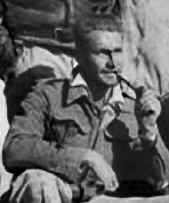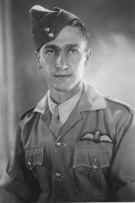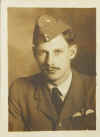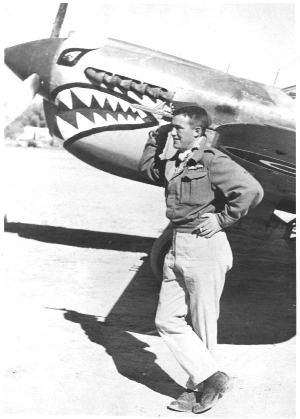I encourage anyone that has more information (Flight Log Book entries) or photos on 112 Squadron please send an e-mail to raf_112_sqdn@yahoo.com before the history is lost.
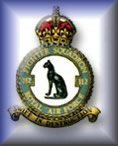
Internet Finds of RAF 112 Sqn Personnel
A to B
The Americans, New Zealanders, The Polish Pilots
Group Captain Richard James "Dickie" Abrahams, RAF no. 37663 victories 2.5
Abrahams was born on 28 June 1912.
He received a short service commission on 27 January 1936, being confirmed in this rank a year later.
He was posted to the staff of HQ, Middle East.
On 27 July 1938 he was promoted to Flying Officer.
Abrahams was posted to 112 Squadron on 29 August 1940.
Abrahams rejoined his unit the next day, on 29 February.
He was posted away from 112 Squadron on 4 March 1941.
He returned to the UK, where he briefly served with 41 Squadron.
He commanded 129 Squadron from September 1941 – January 1942, when he was posted to Air Ministry (Directorate of Plans).
On 1 July 1943 he was promoted to Wing Commander.
Abrahams ended the war with 2 biplane victories, these being claimed while flying Gloster Gladiators.
He remained in the RAF after the war, reaching the rank of Group Captain on 1 January 1954.
Abrahams retired from the service on 27 July 1967, having been awarded an OBE
Squadron Leader Richard " Dickie or Acky"Alvin Acworth DFC, RAF no. 40486
19 December 1916 – 1 March 1971
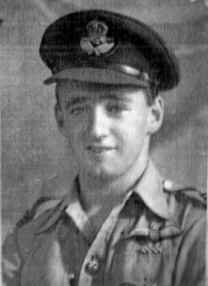
Second photo Photo supplied by Patricia
Acworth taken 1945 Molloy daughter of J.F. Fraser
Squadron Leader Richard " Dickie or Acky"Alvin Acworth DFC, RAF no. 40486, 112, 80 & 118Sqn, Richard Acworth was commissioned in 1937. On 16 May 1939 he was posted to 112 Squadron when this unit was formed aboard HMS Argus in Portsmouth, Hampshire. 112 Squadron was sent to Egypt and arrived on 25 May 1939. When Italy declared war on 10 June 1940 he served as Pilot Officer in ‘A’ Flight.
Record of Service
| No 8 ETS | Reading | 29/11/37 to 5/3/38, Station Officer |
| Uxbridge | 5/3/38 to 19/3/38 | |
| N0 9 ETS | Hullavinston | 20/3/38 to 14/9/38 |
| No 66 Sqn | Duxford | 17/9/38 to 8/5/39 |
| N0 112 (F) Sqn HMS Argus |
Helwan- N, Desert Greece-Palistine Sick Leave /June |
15/5/39 to 1/6/41 |
| Ferry Pool | Abusueir | 1/7/41 to 1/8/41 |
| No 71 OTU | Ismailia | 4/8/41 |
| Gordens' Tree | Sugan | |
| N0 112 Sqdn W. desert | Posting Cancelled | |
| No 55 OTU | Usnorth | 25/3/42 to 6/5/42 |
| No 55 OTU | Annan | 6/5/42 to 13/5/42 |
| No 55 Det Flight | Longtown | 13/5/42 to 2/5/43 |
| C.G.S. | Sutton Bridge | 5/5/43 to 5/6/43 |
| No 118 (F) Sqdn | Coltishall | 2/5/43 |
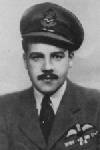
In May 1944 this officer flew the leading aircraft of a formation which engaged a force of eighteen enemy aircraft, nine of which were shot down without loss. By his skilful and determined leadership, Squadron Leader Arthur played a worthy part in this brilliant success. This officer has taken part in a very large number of sorties and has displayed outstanding devotion to duty. He has destroyed two enemy aircraft.
ARTHUR, S/L Charles Ian Rose (41241) - Bar Distinguished Flying Cross - No.72 Squadron - Awarded as per London Gazette dated 29 December 1944.
Squadron Leader Arthur has continued to lead his squadron with skill and determination. Since the award of the Distinguished Flying Cross he has completed many sorties and has destroyed at least one enemy aircraft. During the invasion of the south of France he has led his squadron in many sorties which resulted in the destruction of 37 mechanical transport and other vehicles and damaged many others. His coolness, determination and outstanding leadership have largely contributed to the successes achieved by the squadron.
NOTE: Public Records Office Air 2/9033 has recommendation for this award dated 25 October 1944. It stated he had flown 81 operational hours since previous award, had flown a total of 1,645 hours (145 in previous six months) and had flown a total of 717 operational hours (437 sorties). Text differs little from the published citation:
Squadron Leader Arthur has continued to lead his squadron with skill and determination. Since being awarded the Distinguished Flying Cross this officer has completed many sorties and has destroyed one enemy aircraft and shared in the destruction of another.
During the invasion of the south of France he lead [sic] led his squadron on many sorties resulting in the destruction of some 37 mechanical transport and other vehicles besides damaging many others. His coolness and determination contributed largely to the success of his squadron. Squadron Leader Arthur has now completed over 700 hours operational flying.
LANCE NEVILLE AHERN,
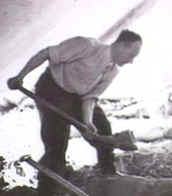
A true Digger seen here preparing to lower the floor of his tented living quarters.
| Name | AHERN, LANCE NEVILLE |
|---|---|
| Service | Royal Australian Air Force |
| Service Number | 402781 |
| Date of Birth | 15 Aug 1912 |
| Place of Birth | NORTH SYDNEY, NSW |
| Date of Enlistment | 14 Oct 1940 |
| Locality on Enlistment | Unknown |
| Place of Enlistment | SYDNEY, NSW |
| Next of Kin | AHERN, LANCE |
| Date of Discharge | 26 Oct 1945 |
| Rank | Squadron Leader |
| Posting at Discharge | 2 OPERATIONAL TRAINING UNIT |
| WW2 Honours and Gallantry |
Companion of the Distinguished Service Order, Distinguished Flying Cross London Gazette issue 36500, 2 may 1944 page 2 0f 4, Flight Lieutenant Lance Neville AHERN (Aus.4O278i),Royal Australian Air Force, No. 112 Squadron. This officer has completed a very large number of sorties and has invariably displayed a high degree of skill and courage, qualities which have been well illustrated on many recent occasions. One day in April, 1944, he flew with much distinction in a successful attack on ground targets. The next morning, Flight Lieutenant Ahern led a formation of aircraft in an attack on shipping during which an enemy motor vessel was, sunk. The same afternoon he led the squadron in an engagement against a number of fighters, 3 of which were shot down. By his inspiring leadership and outstanding determination, Flight Lieutenant Ahern contributed materially to the successes obtained. |
| Prisoner of War | No |
|
|
7 April 1944 |
|||||
|
No. 112 Squadron aircraft and pilots taking part in the combat over Rieti airfield: |
|||||
|
Kittyhawk III |
Pilot |
||||
|
FT854 |
GA/B |
F/L |
L.N. Ahern |
Aus. 402781 |
|
|
FR857 |
GA/V |
F/S |
K.C. Warburton |
(shot down at 17.10 hours) |
|
|
FR862 |
GA/E |
F/S |
B.H. Peters |
Aus. 409439 |
|
|
FR312 |
GA/J |
F/O |
M.N. Matthias |
||
|
FR288 |
GA/Z |
F/S |
W.E. Cocks |
(shot down at 17.10 hours) |
|
|
FR507 |
GA/R |
Lt. |
M.G. White |
SAAF 75645V |
|
|
FR390 |
GA/F |
W/O |
R.W. Drown |
||
|
FR257 |
GA/H |
Lt. |
H.J. Hanreck |
SAAF 207359V |
|
|
FR354 |
GA/W |
W/O |
N.E. Swinton |
Aus. 401457 |
|
|
FR309 |
GA/Q |
F/O |
J.O. Gray |
Can. J.16543 |
|
|
FR236 |
GA/S |
F/S |
J.L. Jellett |
||
|
FL895 |
GA/A |
F/S |
A.G. Rowe |
||
|
Notes: |
Of those pilots who flew on both this and the squadron's morning mission, Swinton was the only one to fly the same aircraft each time. F/O Matthias was killed over Austria on 2 April 1945. |
||||
Following From: http://members.tripod.com/mick_quinn/id60.html
Ahern trained in Rhodesia at 26 EFTS and on Harvards at 22 SFTS. He was commissioned as Pilot Officer before leaving Rhodesia on 2 September 1941 on the S. S. Mauretania, and arriving in the Middle East on the 21 October. After a course at 74 OTU at Aquir, Palestine. 27 Jan 42 - joined 451 Sqdn with whom he flew Hurricanes until posted to 112 Sqdn RAF. 44 - F/L Ahern and F/Sgt Peters were out on patrol and encountered a formation of FW-190's. F/Sgt Peters blew one of the enemy aircraft to pieces in the air and F/L Ahern inflicted damage to several others. After a spirited engagement Ahern took hurried stock of the damage done to his Kittyhawk and found to his dismay that the airspeed indicator and half the starboard elevator had been shot away. There was a hole clean through the port mainplane one yard long by eighteen inches wide. There was also a gap in the rudder big enough to allow a pair of fists through and that the port tail plane and aileron were also holed. Ahern's achievement in getting his aircraft back to base, a matter of a 100 mile flight, is a striking illustration of just how much punishment a Kittyhawk can take. With these two squadrons he completed 340.40 operational hours in 242 soties, before being given a rest from operations by being appointed to a planning position at Advance Headquarters of the Desert Air Force. He remained there until he returned to Australia on 29 October 1944 where he was posted to become an instructor at 2 OTU Mildura, where he remained until discharged on the 26 October 1945 with the rank of Squadron leader and having been awarded the DSO and DFC.
References: Australian War Memorial Picture No MEA1492, MEA1497, P00869.036
| Name | ALLISON, GEORGE FRAME |
|---|---|
| Service | Royal Australian Air Force |
| Service Number | 402782 |
| Date of Birth | 22 Nov 1919 |
| Place of Birth | SOUTH SHIELDS, ENGLAND |
| Date of Enlistment | 14 Oct 1940 |
| Locality on Enlistment | Unknown |
| Place of Enlistment | SYDNEY, NSW |
| Next of Kin | ALLISON, GEORGE |
| Date of Discharge | 28 Sep 1945 |
| Rank | Squadron Leader |
| Posting at Discharge | 2 ADU |
| WW2 Honours and Gallantry | None for display |
| Prisoner of War | No |
**************************************************************************
Gazette Issue 35171 published on the 23 May 1941. Page 11 of 64
810145 Aubrey Cyril BAKER '(64892) Seniority 9th April 1941 Pilot Officer on probation
5266 SUPPLEMENT TO THE LONDON GAZETTE, 4 DECEMBER, 1942
Distinguished Flying Cross.
Acting Flight Lieutenant Aubrey Cyril BAKER '(64892), Royal Air Force Volunteer Reserve, No.112 Squadron
http://www.gazettes-online.co.uk/archiveSearch.asp?WebType=0&Refer
Flying Officer Edwin Thomas "Teddy" Banks, RAF no. 40978,
RAF 112 Sqdn service 16/5/39 to 13/03/41
Photo supplied by Patricia Molloy daughter of J.F. Fraser
Edwin Banks was born in 1920 and was from Nottingham.
He received a short service commission on 20 August 1938.
On 16 May 1939 he was posted to 112 Squadron when this unit was formed aboard HMS Argus in Portsmouth, Hampshire.
112 Squadron was sent to Egypt and arrived on 25 May 1939.
He was promoted to Flying Officer on 3 September 1939
TEDDY BANKS was killed in March 1941 testing a Gladiator over Lake Yannina, Greece.
He was my wife, Pats uncle. Teddys elder sister Doris (Pats mother) would never talk about her
beloved brother and his loss. So our research has all been on the internet
Ian Griffiths
1920 – 13 March 1941 above not to be confused by the following A Banks
SECOND SUPPLEMENT to the London Gazette
Of FRIDAY, the is/ of NOVEMBER, 1946
Registered as a newspaper
Registered as a newspaper TUESDAY, 5 NOVEMBER, 1946
CENTRAL CHANCERY OF THE ORDERS OF
KNIGHTHOOD.
St. James's Palace, S.W.I.
Sergeant Arthur BANKS,
1607992, Royal Air Force Volunteer Reserve, No. 112 Squadron, Desert Air Force.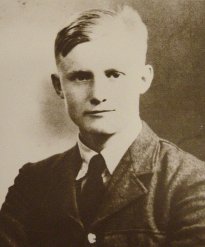
5th November, 1946.The KING has been graciously pleased to approve the posthumous award of the GEORGE CROSS to: — 1607992 Sergeant Arthur BANKS, Royal Air Force Volunteer Reserve, No. 112 Squadron, Desert Air Force. On 29th August, 1944, this airman took part in an armed reconnaissance of the Ravenna and Ferrara areas. During the sortie, his. aircraft was damaged by anti-aircraft- fire and he was compelled to make a forced landing. After the aircraft had been destroyed, Sergeant Banks decided to try to reach the Allied lines. He made contact with a group of Italian partisans, amongst whom, during .the following months, he 'became an outstanding figure, advising and encouraging them in action against the enemy. Early in December, 1944, an attempt at crossing into allied territory by boat was planned. Sergeant Banks and a number of partisans assembled at the allotted place, but the whole party was surrounded and captured. Sergeant Banks was handed over to the German commander of the district, who presided at his interrogation. During the questioning, Sergeant Banks was cruelly tortured. At one stage, he succeeded in getting hold of a light machine gun, with which he might have killed most of his captors, had not. one of the partisans, fearing more severe torture, intervened and pinned his arms to his sides. Sergeant- Banks was badly knocked about before he was taken to another prison. On 8th December, .1944, Sergeant Banks was taken, with a number of partisans, to a prison at Adria. He remained there until igth December, 1944, when he was handed over to the commander of a detachment of the '' Black Brigade ''. He was then transferred to another prison at Ariano Polesine. Here, in the presence of Italian Fascists, he was stripped of his clothing and again tortured. Sergeant Banks was eventually bound and "thrown into the River Po. Despite his wounds, even at this stage, he succeeded in reaching the river bank. The Fascists then took him back to the prison, where he was shot through the head. At the time of his capture, Sergeant Banks was endeavouring to return to' the Allied lines, so that he might arrange for further supplies to the partisans. He endured much suffering with stoicism, withholding information which would have been of vital interest to the enemy.. His courage and endurance were such that they impressed even his captors. Sergeant Banks' conduct was, at .all times, in keeping with the highest traditions of the Service, even in the face of most brutal and inhuman treatment.
Captain Charles Banks - pre-war schoolmaster, nicknamed “Sandy”, and rejoicing in the second name of Chaplin - yes, Charles Chaplin Banks. After training, which I’d guess occurred sometime during 1917, he joined 44 Squadron on Home Defence duties, and during his time on the unit shot down a Gotha bomber. Posted to 43 Squadron in early 1918 and was a flight commander. Remained with 43 until the end of the war, and was awarded the DFC. He too was an ‘ace’ (although, of course, the RFC/RAF have never formally recognised the concept of ‘aces’). There is a postscript...
His son Arthur served with the RAF in WW2 as a pilot in 112 Squadron (the famed ‘Shark Squadron’). He was shot down in August 1944, but evaded capture and joined with Italian partisans. He fought with them until December, when it was arranged for Banks Jr to rejoin allied lines. His party was ambushed and he was captured by Italian fascists. He was badly beaten during interrogation, and then tortured. He said nothing and attempted to escape. He was eventually murdered by his captors. His captors were all tried at the end of the war by British courts martial and they were imprisoned for between 4.5 and 20 years, save the one who directed Banks’s torture. He was captured by the Italians - who shot him. Arthur Banks was awarded a posthumous George Cross. Details of the son can be found at http://www.stedwards.oxon.sch.uk/banks.html - again, I don’t know off hand what happened to Charles Banks after the First World War since Above the Trenches doesn’t say. He did, however, collect his son's GC from King George VI in 1946
Bill Bailey, Mechanic (engine basher)
LAC Jack Barber
John 'Jack' Bartle DFC, 406171, RAAF, RAF 112 Sqdn service 31/8/41 to 27/5/42
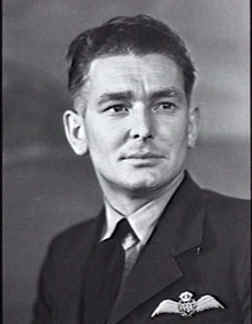
London, England. C. 1944-01. Portrait of 406171 Squadron Leader J. P. BARTLE, from Waroona, WA, at RAAF Overseas Headquarters, after his arrival from the Middle East he has been awarded the DFC 1944-01-06.London, England. Squadron Leader J. P. Bartle DFC, RAAF, served with the Desert Air Forces from 1941 until the end of 1943. He did two operational tours in support of the Eighth Army in its advance through North Africa, Tunisia and Sicily to the front in Italy. For his non-operational tour he commanded an RAAF Air Ambulance unit operating from Cairo and Alexandria to the front line.
Often flew AN413, K, as did Sgt W E Carson (12/10/41) and P/O R D J Jeffries, it was coded 'K' and had 'Nan' in outline under the cockpit and forward of that a Kangaroo also in outline while with 112 Sqn., AN413 ,K went missing in action while being piloted by P/O R J D Jeffries, killed in action.(12/12//41),
P/O 406171 John Phillip Bartle Australian Ace, 112 Sqn. RAF, El Adem - Egypt, October 1941. 6,5 victories He went on to become CO of 450 Sqdn 1942-11-02 served with 112 Sqdn RAF, under RAF control; he survived being shot down in Kittyhawk Mk I, AK632 on 13/3/42.
| Service | |
|---|---|
| Name | BARTLE, JOHN PHILLIP ,112 & 450Sq, Merston wing; victory count 6.5 |
| Service | Royal Australian Air Force |
| Service Number | 406171 |
| Date of Birth | 6 Jun 1916 |
| Place of Birth | COOLGARDIE, WA |
| Date of Enlistment | 12 Sep 1940 |
| Locality on Enlistment | Unknown |
| Place of Enlistment | PERTH, WA |
| Next of Kin | BARTLE, NANCY |
| Date of Discharge | 20 Jul 1945 |
| Rank | Flight Lieutenant |
| Posting at Discharge | SCHOOL ARMY CO-OP |
| WW2 Honours and Gallantry | Distinguished Flying Cross |
| Prisoner of War | No |
| Date of birth | 1917-06-06 | |
| Date and unit at enlistment (ORs) | 1940-09-12 | |
| Other units | 1941 | No 112 Squadron. |
| Date promoted | 1941-06-03 | Pilot officer. |
| Date promoted | 1941-12-03 | Flying officer. |
| Other units | 1942 | Commanding Officer No 1 Air Ambulance Unit. |
| Date promoted | 1942-03-24 | Acting flight lieutenant. |
| Other units | 1942-11-02 | Commanding Officer No 450 Squadron. |
| Date promoted | 1943-03-14 | Acting squadron leader. |
| Date promoted | 1943-06-03 | Flight lieutenant. |
| Date of discharge | 1945-07-20 |
Pilot Officer Leonard Lawrence ‘Len’ Bartley, RAF no. 42182,
RAF 112 Sqdn service 30/7/40 to 31/5/41, POW
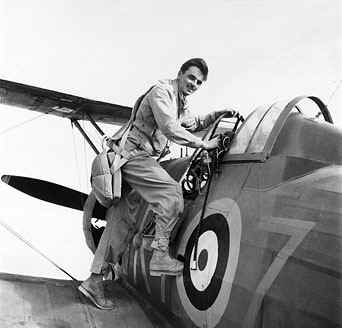
Leonard Bartley was a Canadian from Saskatoon, Saskatchewan.
He joined the Royal Navy during 1932, serving briefly until 1933.
In 1938, still not having reached his 24th birthday, he joined the RAF and was granted a short service commission on 24 June 1939, ( The London Gazette dated 11 July 1939 issue 4769) being confirmed as a Pilot Officer on 1 May 1940.
On completion of training he was posted to 55 Squadron in Egypt to fly Blenheims.
He was posted to 112 Squadron on 30 July 1940.
Captured by an Italian submarine trying to escape Greece he spent 28 months as a POW
Bartley ended the war with 2 biplane victories, these being claimed while flying Gloster Gladiators.
He returned to Canada after the war, settling in Ottawa, where he ran Pathfinder Air Surveys.
‘Len’ Bartley died in 1985
following is from the above linked website;
In Greece, when the retreat from Yannina began, Bartley lost his chance to fly a Gladiator to Eleusis through the toss of a coin and was obliged to hitchhike his way to Athens with five of the ground crew. A Blenheim took him to Crete.
On 5 May Ju88s were intercepted over the Heraklion sector by two 112 Squadron Gladiators flown by Pilot Officer Bartley and Pilot Officer Gerald Westenra. Each pilot claiming a bomber damaged.
On the 2 June, a day after the British forces on Crete had surrendered, three of 112 squadron airmen, ACI McLennan (539503 ACI McLennan, G R, Fitter IIE), LAC Harrington and AC Malloy, together with Flying Officer R. J. Bennett and Pilot Officer Bartley and men of various other units, found two abandoned German invasion barges on the rocks of the south coast of Crete in the Tymbaki area. One was holed and the other had an unserviceable engine so the airmen transferred the good engine to the seaworthy barge. They managed to launch it and, having collected water and rations (during the day a Blenheim swooped low over the party and dropped a quantity of most welcome rations) and fuel, set off for Egypt. Aboard were six officers and 66 men. Other known officers were Lieutenant E. G. Ford of 24 SAAF Squadron, and his observer, Second Lieutenant G. L. W. Gill (both from a Maryland that was shot down on 25 May) and a wounded Australian officer.
On board the submarine, the prisoners, who had not been able to wash for many days, were not only rather unwholesome but were also infested with fleas so the Italians took immediate steps to have them landed at Taranto, their first port of call.
From there Bartley was taken to a PoW camp at Sulmona, some 75 miles east of Rome where he languished for the next twenty-eight months.
In September 1943, when the Italians surrendered to the Allies, it seemed possible that all the prisoners would be released, but the Germans began moving in to take over control of the PoW camps. There were rumours that there would be a massacre of prisoners and the Italian guards attempted to defend them. In the confused fighting outside the wire Bartley made his escape, using a homemade wire-cutter.
Once free he, in his own words, `kept running for 24 hours without stopping!' Although disguised by the old clothes he wore he inevitably aroused suspicion and was frequently interrogated by civilians as he made his way south but he managed to shake them off and only once did he find himself in any danger when a seemingly friendly farmer gave him a bed for the night in his barn. Later he discovered that the barn door had been bolted on the outside and he realised his host was probably getting in touch with the local Military.
Determined not to be captured again, Bartley cut his way out and continued his journey south. At a place called Alberona, on a tributary of the river Salsola, Bartley was able to meet the mayor of the town who spoke English and who controlled a band of partisans. This group set off hoping to reach Allied lines but their garrulously argumentative progress was so noisy that they alerted a German road block and in the shoot out that followed Bartley was wounded in both legs. Nevertheless he was able to avoid being captured and somehow made contact with `Popsky's Private Army' (a small scouting force attached to the 8th Army commanded by Lieutenant Colonel V. Peniakoff a Russo-Belgian officer who had at one time been associated with the North African Long Range Desert Group), which was operating in the area behind enemy lines. With their help he reached Lucera, north of Foggia, and was soon liberated by the British advance.
Almost immediately, though, Bartley succumbed to malaria and his leg wounds and was hurried to hospital.
He did not see any further action before the end of war. He returned to Canada after the war, settling in Ottawa, where he ran Pathfinder Air Surveys.
‘Len’ Bartley died in 1985
Bill (Yippie) Barwick, mechanic 112
Sqdn Italy, read about him hereLAC Thomas Burrows, ran away from home around the time of his 16th birthday to join the RAF, and he trained as an Airframe Fitter as an Apprentice at RAF Halton around 1938. His first posting was to the Fleet Air Arm, and HMS Illustrious, he later transferred to 112 Squadron and went to Yanina in Greece. Here, according to his father, they lost all but one of their Gladiators on the first day of the German invasion. From Greece they moved to Maleme on Crete. After being attached to the New Zealand infantry during the battle, where he was Mentioned in Dispatches around Maleme he was captured, but escaped pretty quickly, making his was over the White Mountains to Sfakia, he was evacuated on HMS Phoebe In a letter dated 24 January 2005, his son John writes ."In Egypt he seems to have been assigned to 148 Squadron and thus ended his association with 112 Squadron." His son John graciously donated pictures found on page 7 of the photos pages.
Flying Officer Richard John
Photo of Bennett supplied by Patricia Molloy daughter of J.F. Fraser
Bennett received a short service commission in August 1938. On 16 May 1939 R. J. Bennett was posted to 112 Squadron when this unit was formed aboard HMS Argus in Portsmouth, Hampshire.112 Squadron was sent to Egypt and arrived on 25 May 1939.
His rank of Pilot Officer was confirmed in June. When Italy declared war on 10 June 1940 he served in ‘C’ Flight.
On 3 July 1940 Flying Officer R. H. Smith and Flying Officer Bennett of 112 Squadron was sent to 33 Squadrons 'A' Flight at Sidi Barrani to gain battle experience. Later Bennett accompanied 112 Squadron to Greece and took part in that campaign, he later took part in the defense of Crete.
On the 2 June, a day after the British forces on Crete had surrendered, three of 112 squadron airmen, ACI McLennan (539503 ACI McLennan, G R, Fitter IIE), LAC Harrington and AC Malloy, together with Flying Officer Bennett and Pilot Officer Len Bartley and men of various other units, found two abandoned German invasion barges on the rocks of the south coast of Crete in the Tymbaki area. One was holed and the other had an unserviceable engine so the airmen transferred the good engine to the seaworthy barge. They managed to launch it and, having collected water and rations (during the day a Blenheim swooped low over the party and dropped a quantity of most welcome rations) and fuel, set off for Egypt. Aboard were six officers and 66 men. Other known officers were Lieutenant E. G. Ford of 24 SAAF Squadron, and his observer, Second Lieutenant G. L. W. Gill (both from a Maryland that was shot down on 25 May) and a wounded Australian officer.
In the early morning of the second day when the barge was about 30 miles out a submarine commander in perfect English hailed them. Believing this to be a Royal Naval vessel they answered cheerfully and received a burst of machine-gun fire in return. The Italian submarine commander probably then realized the British were unarmed and the officers were then ordered to swim to the submarine, but whilst attempting to do so, Gill was tragically drowned. The wounded Australian officer who had been left aboard was now ordered to return the craft to Crete, but Sergeant D. D. McWilliam, one of the Maryland crew, assumed command, decided to ignore the order and continued towards the North African coast.
After four days, traveling at about 4 knots, 'McLennan's barge' reached the Egyptian coast. After a while they recognized the sand dunes of Mersa Matruh and, seeing British troops, came ashore.
On board the submarine, the prisoners, who had not been able to wash for many days, were not only rather unwholesome but were also infested with fleas so the Italians took immediate steps to have them landed at Taranto, their first port of call. Bennett remained a PoW for the rest of the war. He was promoted Flight Lieutenant whilst in captivity.
Sgt W Richard Blake (American), R97463, RCAF,
was a Canadian residing in Corpus Christie, TexasAnthony Peter Questil BLUETT, D.F.C (43539),
2nd Lieutenants.
Antony Peter Questil BLUETT (R.T.R.)
Officer: —23rd Jan. 1941. Antony Peter Questil BLUETT (2nd Lt. R.T.R.) (43539)-
Pit. Offs. (prob.) confirmed in their appts.'
I3th May 1942.
A. P. Q. BLUETT (2nd Lt. R.T.R.) (43539)
Distinguished Flying Cross
Gazette Issue 35983 published on 16 April 1943 Page 1 of 10
Flight Lieutenant Anthony Peter Questil BLUETT
flown on several sorties, involving low level
an attack on enemy forces which threatened a
landing. This officer has displayed great courage,
Air Ministry, 2Oth March, 1945.
The KING has been graciously pleased to approve
the following awards.
Bar to Distinguished Flying Cross.
Acting Squadron Leaders.
Anthony Peter Questil BLUETT, D.F.C (43539),
R.A.F., 112 Sqn
Flight Lieutenant Neville Bowker (89773) DFC, RAF
This is a photo of Neville Bowker with one of the Wright Bros descendents taken in Greece Thanks Colleen and Family He was born in Kimberly, South Africa on 17th September 1918 but left with his parents when he was two, for Rhodesia, where he grew up. He joined the Southern Rhodesian Air Force in February 1940, then was transferred to the RAF in Iraq to finish his training. He was sent to 112 Squadron in Greece and then Crete flying Gladiators, and escaped on the last evacuation ship the "Orion". After recovering in Cairo he returned to 112 Squadron, then in the desert, where they were eventually equipped with Tomahawks. He was shot down on the 27th December 1941, and ended the war as a POW in Stalag 3. He also received the DFC and was mentioned in dispatches twice.
After the war he returned to Rhodesia where he farmed, moving to Northern Rhodesia and then Mozambique where he lost everything to Frelimo. After moving back to Rhodesia and then South Africa he eventually came to Australia.
He died on the 21st May 2005 leaving a son and three daughters, ten grandchildren and four great-grandsons."
THE LONDON GAZETTE, 36192, 28 September, 1943 page 3 of 10
Distinguished Flying Cross. Flight Lieutenant Neville BOWKER (89773), Royal Air Force Volunteer Reserve, No. 112 Squadron, awarded with effect from 6th January, 1942.
Flight Lieutenant Neville Bowker (89773), Had two Favorite Planes in 112 Sqn AK461,
Flight Lieutenant Neville Bowker (89773), Had two Favorite Planes in 112 Sqn AK461, coded A and AN218, coded B, named Menace, Royal Air Force Volunteer Reserve, No. 112 Squadron, DFC , 112Sq; POW 27/Dec/1941, victories 10.33. Neville Bowker was born in 1918 in the Orange Free State, South Africa, but was brought up in the Southern Rhodesia. He joined the SAAF, but transferred to the RAF in mid 1940, being commissioned in the RAFVR. He attended 70 OTU at Nakuru, joining 112 Squadron on 14 February 1941.He served as a Pilot Officer in 112 Squadron, when the unit moved to Greece in early 1941. During the evening on 11 May 1941 five Bf110s of II/ZG 76, which had arrived at Argos from North Germany four days earlier, swept in over Heraklion airfield to strafe. Insufficient warning allowed only a single 112 Squadron Gladiator to get into the air, but Bofors and Lewis gunners opened fire as the Bf110s swept round the airfield. As they completed their circuit, Pilot Officer Bowker attacked one and a low level dogfight commenced, during which the lone Gladiator pilot attempted to lead his opponents over the gun positions. After a few minutes the Bf110s made off to the north-west, Bowker landing to claim one probably shot down.This claim was definitely confirmed destroyed in the Command Intelligence Summaries. On 14 September, 1941, six Tomahawks from 112 Squadron received an R/T message that there was a ‘bandit’ over Mersa Matruh at 19,000 feet. The formation climbed to about 16,000 feet and spotted a S.79 bellow Flight Lieutenant Harrison engaged the S.79, which he hit. The Italian bomber was then engaged by Pilot Officer Neville Bowker firing his wing guns only as his .5” machine gun had jammed. He reset and returned to the attack and at 150 yards, he saw petrol streaming from the enemy aircraft. He pumped shots into the starboard engine and the fuselage and the S.79 blew up.
This was 112 Squadrons 77th victory and the first with their new P-40 Tomahawk IIBs.
On the 27 December 1941 he was shot down by small arms fire when strafing, flying a Tomahawk (AN283 ? or was it AN218). The Germans took him prison again, but this time for the rest of the war. The award of a DFC was announced in October 1943, but with effect from 6 January 1942, by which time he had been promoted to Flight Lieutenant.
Bowker was credited with 2 biplane victories and a total of 10 victories at the time of his capture.
After the war he returned to Southern Rhodesia and married. He farmed together with his wife Colleen in Rhodesia and Mozambique and ended in South Africa in Mining machinery.
They retired to Australia in 1992 where he and his son have been instrumental in producing the first machine to remove the meat from coconuts.
Neville G "Bowks" Bowker, Jerry Westenra & Jack Bartle1995, Colleen in the back ground
UPDATE: 24 MAY 2005 E-mail received from his Colleen
Flight Lieutenant Neville Bowker DFC RAF 112 Squadron nos 779035 and 89773 (officer). This is to tell you that Neville Bowker passed away on Saturday 21st May in Australia. I would be very interested to know if there are survivors of 112 Squadron from the Crete episode still alive. He did not die in a car accident in Turkey as reported but led a full life in Rhodesia and Mocabique and South Africa before ending up in Australia. He leaves four children, ten grandchildren and 3 great grandsons and his wife Colleen. Colleen is now residing in the Glasshouse Mountains in Australia.
Yours sincerely
A letter to his parents from his fitter
530802 Sgt Williams
C/o R A T G
SALISBURY
Feb 18th 1944
Dear Mr and Mrs Bowker,
This is to let you know that I’m not to have the chance to accept your invitation to visit you in Umtali. I am leaving for home shortly and although I have tried to get leave to come and see you, I have been all the time on a day –to -day system of waiting and now in about a week or so I shall leave the Colony, ultimately to go home. Believe me it was my dearest wish to have the honor of speaking with the parents of my old boss, who was by far the finest type of officer it has been my privilege to serve. I am enclosing a snap of Mr Bowker’s aircraft – it was his own particular ‘kite’ and in it he did things that no one who served with our beloved 112 Sqrn can ever forget. As you’ve never seen me I’d better tell you that I’m the corporal standing second on right. (picture not available)
You can imagine what the conditions were like by looking at our general rag-tag appearance.
Now I’m going home to get married and there’s a request I’d like to make. Permission from you to name any of my kiddies ( and I intend to have one or two believe me) after your son. We know him as Neville but of course what his second name might have been I do not know. And if my youngster grows up to be as fine and courageous as yours I shall be satisfied.
If you would like to drop me a line before leaving, please do so. And next time you write to Mr Bowker, please tell him his old fitter will never forget him and that he wishes him with all his heart speedy return to Rhodesia.
Thanking you for asking me to your home.
I remain Faithfully yours
D. (?). Williams.
Claims:
| Kill no. | Date | Number | Type | Result | Plane type | Serial no. | Locality | Unit |
| 1941 | ||||||||
| 1 | 11/03/41 | 1 | G.50 (a) | Destroyed | Gladiator II | N5817 | Tepelene-Bousi | 112 Squadron |
| 13/03/41 | 1 | CR.42 (b) | Probable | Gladiator II | N5817 | Bousi | 112 Squadron | |
| 14/03/41 | 1 | G.50 (c) | Probable | Gladiator II | N5817 | E Valona | 112 Squadron | |
| 13/04/41 | 1 | S.79 | Damaged | Gladiator II | N5858 | Koritza | 112 Squadron | |
| 2 | 11/05/41 | 1 | Bf110 (d) | Destroyed | Gladiator II | N5858 | Heraklion | 112 Squadron |
| 3 | 14/09/41 | 1 | S.79 | Destroyed | Tomahawk IIb | AN218 | Sidi Barrani | 112 Squadron |
| 20/11/41 | 1/3 | Bf110 | Shared destroyed | Tomahawk IIb | AN415 | El Adem-Acroma | 112 Squadron | |
| 20/11/41 | 1 | Bf110 | Probable | Tomahawk IIb | AN415 | El Adem | 112 Squadron | |
| 4 | 25/11/41 | 1 | Bf110 | Destroyed | Tomahawk IIb | AK503 | 1-2m off Tobruk | 112 Squadron |
| 5 | 30/11/41 | 1 | MC.200 | Destroyed | Tomahawk IIb | AN338 | El Gobi | 112 Squadron |
| 6 | 04/12/41 | 1 | G.50 | Destroyed | Tomahawk IIb | AN372 | El Adem-Sidi Rezegh | 112 Squadron |
| 7 | 04/12/41 | 1 | Ju87 | Destroyed | Tomahawk IIb | AN372 | El Adem-Sidi Rezegh | 112 Squadron |
| 05/12/41 | 1 | G.50 (e) | Damaged | Tomahawk IIb | AK509 | S El Adem | 112 Squadron | |
| 8 | 05/12/41 | 1 | Ju87 | Destroyed | Tomahawk IIb | AK509 | S El Adem | 112 Squadron |
| 9 | 05/12/41 | 1 | Ju87 | Destroyed | Tomahawk IIb | AK509 | S El Adem | 112 Squadron |
| 10 | 05/12/41 | 1 | Ju87 | Destroyed | Tomahawk IIb | AK509 | S El Adem | 112 Squadron |
He maintained that his ground crew were out of this world and took great pride in getting anything airborne ASAP. I have inherited a letter written by -- Williams then in Rhodesia presumably posted there for a time, then on his way back home to England who seemed to hero worship 'his old boss" Her is something from his logbook showing what I mean.
7 Nov 1941 218 patrol ----xxooc
7 " 218 interception
8 321 patrol
9 / 12th 218
14 ... Hurricane (Aboukir)
15 317 Tomahawk
16/22 218 ---xxxooo
24 /26 461
25 /29 218
1 Dec /3 326 patrol ---xo
4 /8th 218
9 507 patrol ---xo
10 / 17 218
18 218 patrol --xo
20 321
21 /25 218 no more entries for the war.
This is why I think he was shot down in 218 and that it was the Menace. Another one is Gladiator 5917 as destroyed on 15.03.41. In the log book he flew it again on March 22nd (twice) and 23rd and 26th x four times that day,----ground straaf and presume it was written off Until 31st they were all odd planes. Then I presume they evacuated. Don't know whether this has been any help. I shall try to get the Logbook copied
Sincerely Colleen.
HENRY GEORGE BURNEY, 402343, RAAF

|
BURNEY, HENRY GEORGE |
|
|
Royal Australian Air Force |
|
|
402343 |
|
|
6 Dec 1915 |
|
|
CROYDON, NSW |
|
|
19 Aug 1940 |
|
|
SYDNEY, NSW |
|
|
BURNEY, CHARLES |
|
|
30 May 1942 |
|
|
Pilot Officer |
|
|
112 Squadron |
|
|
No |
|
|
SYDNEY NSW |
F/Sgt David B. Brown, 1381428, with RAF 112 Sqn from 2/9/42 to 9/12/43

David B. Brown, who flew Kittyhawks in No. 112 in 1942 and later Supermarine Spitfires, recalled: "The Kittyhawk, while offering a more roomy and comfortable cockpit than the Spitfire, with a bonus of improved visibility, was more sluggish on controls and inferior in performance when compared with the Spitfire V. Furthermore, even though we could cope with moderate aerobatics and mock dogfights, there was still a feeling of 'touchiness' about the P-40 so that you wanted plenty of altitude before you could relax...." Hawk with Shark's Teeth: Curtiss P- 40, This article was written by Robert Guttman and originally published in Aviation History Magazine in November 2000. Robert Guttman serves as a chief mate in the U.S. merchant marine.
Flying Officer Ephraim Hugh Brown, RAF no. 41777 , 112 Sqn. 30/10/40 to 14/4/41, 1917-1942, son of Ephraim Hugh Brown and Elsie Brown, Portaferry, Ireland
Just came across your web site. My cousin Hughie Brown [who died long before I was born] served with 112 Squadron from the end of October 1940 to mid April 1941.
Hughie came from Portaferry, Northern Ireland, and I understand had joined the RAF a year or two before the War started. He was serving with 230 Squadron when he was reported missing in action on 25th July 1942. He was piloting a Sunderland flying boat that took off from Aboukir, near Alexandria, on a routine coastal patrol for submarines, and which never returned. There was no radio contact from the flight and no sign of the plane was ever found. Above is a photo of Hughie. I hope you can use it for your web site - sorry, I am not very expert with e-mails and attachments.
Belfast
E-mail contact with his relative Tom relates the following about E H (Hughie) Brown.
Wing Commander Harry Lennox Innes Brown, RAF No. 37060
Had prior service with 80 Squadron at Ismailia and Ramleh. (source The Gloster Gladiator, Francis K. Mason)
F/Sgt (rank at time picture was taken) Wilfred David Brown R86267 his Squadron nick names where "Canada“ and "Western Desert“.
Second photo is a news clipping of the time appeared in the Globe and Mail 20 November 1942
Flying Officer Peter Charles Lindsay Brunton, RAF no. 89774 victories 1
Pilot Officer A.R "Jack" Butcher, 70104, RAF, POW
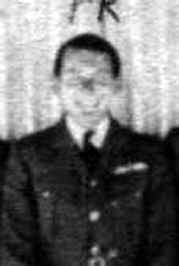
Photo supplied by Patricia Molloy daughter of J.F. Fraser
